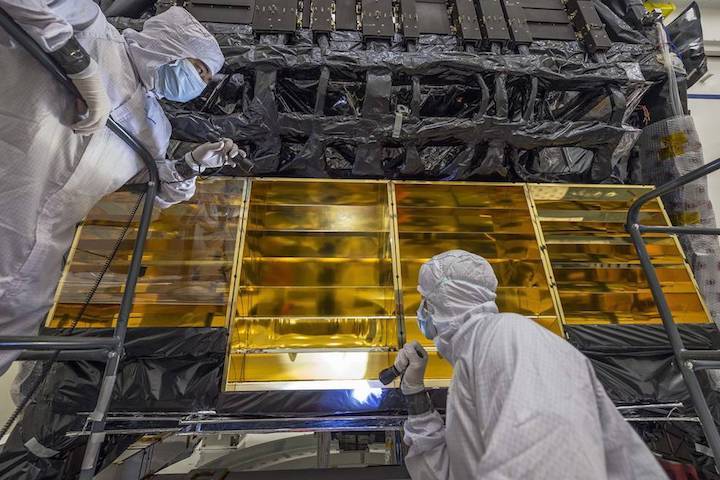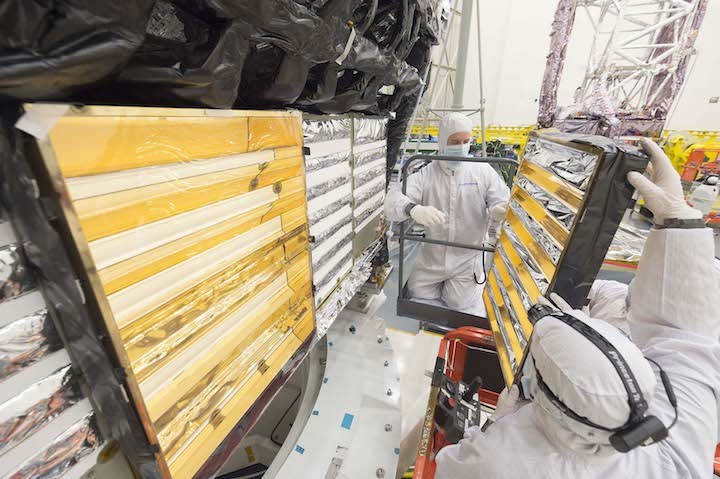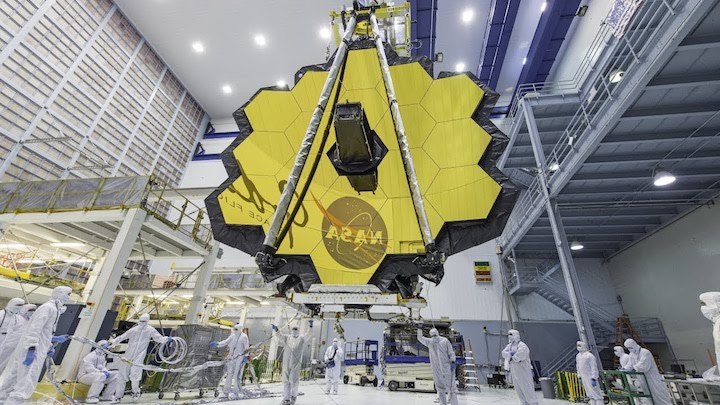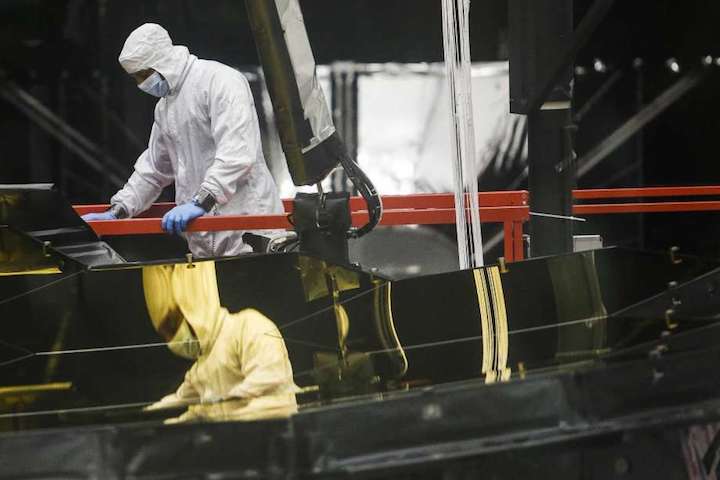4.05.2018
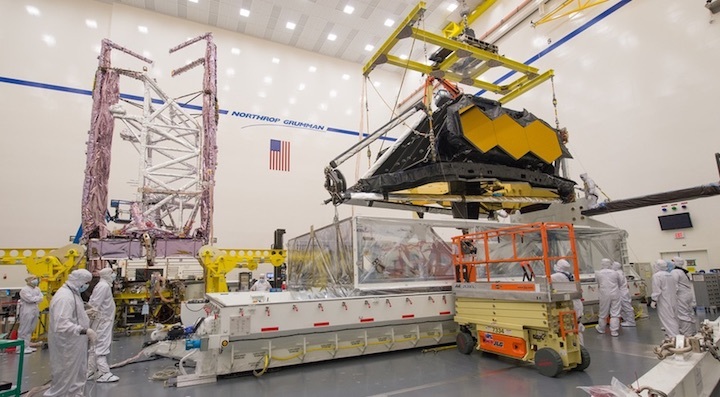
WASHINGTON — As an independent review of NASA’s James Webb Space Telescope continues, the project is dealing with a new problem discovered in recent testing of the spacecraft.
In a presentation at a meeting of the National Academies’ Space Studies Board here May 3, Greg Robinson, the JWST program director at NASA Headquarters, said some “screws and washers” appear to have come off the spacecraft during recent environmental testing at a Northrop Grumman facility in Southern California.
Technicians found the items after the spacecraft element of JWST, which includes the bus and sunshield but not its optics and instruments, was moved last weekend from one chamber for acoustics tests to another to prepare for vibration testing.
“Right now we believe that all of this hardware — we’re talking screws and washers here — come from the sunshield cover,” he said. “We’re looking at what this really means and what is the recovery plan.” The problem, he said, was only a couple of days old, and he had few additional details about the problem.
“It’s not terrible news, but it’s not good news, either,” he said.
The incident, Robinson argued, showed the importance of the wide range of tests the spacecraft is put through prior to launch. “That’s why we do the testing,” he said. “We do it now, we find it now, we fix it and we launch a good spacecraft.”
This latest incident comes as an independent review board, chartered by NASA in late March after announcing a one-year delay in JWST’s launch because of other technical issues, is in the midst of its analysis of the mission and its launch readiness. That review, led by retired aerospace executive and former NASA Goddard director Tom Young, is scheduled to be completed at the end of the month.
“It was a no-brainer to put an independent review board in place,” Thomas Zurbuchen, NASA associate administrator for science, said at the Space Studies Board meeting May 2. The board, he said, will provide an independent look at the status of the mission and identify what needs to be done to ensure the mission will be successful.
Zurbuchen said there would be a “little bit of a pause” after the board delivers its final report, in part because of a prior commitment by Young in early June that makes him unavailable for discussions about the report or additional work. He said NASA will start briefing Congress and others about the report, and the agency’s response, in late June.
That report will allow NASA to refine a launch date of approximately May 2020 that it announced March 27. Robinson believed there was margin in the revised development schedule to maintain that date. “We believe we have good margin there, and a lot that margin is for things like we just experienced,” he said. “I still believe we’ll go in 2020, in roughly the same timeframe that we talked about, unless this problem takes longer than we expect.”
One lesson already learned, he said, was the need for more NASA oversight of Northrop Grumman’s work. “We had people in the plant for a long time, four or five people,” he said. “We’ve added a lot of folks in the past five or six months for oversight at Northrop Grumman.”
Quelle: SN
---
Update: 9.05.2018
.
JWST beset by another problem as Northrop Grumman revamps training
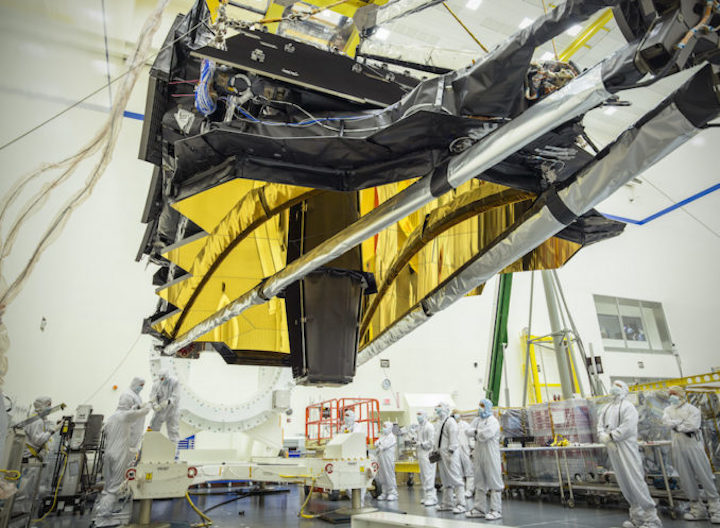
Engineers working on the James Webb Space Telescope, which had its launch delayed to 2020 earlier this year, recently discovered another problem during testing at the observatory’s prime contractor Northrop Grumman in Southern California.
Teams at Northrop Grumman inspecting JWST’s spacecraft element after an acoustic test found fastening hardware had come loose, according to a NASA statement issued Friday. The spacecraft module, which will be mated to the observatory’s telescope section before launch, includes propulsion and power systems, plus a five-layer sunshield to keep the observatory’s telescope in shadow while in space.
NASA said in a statement Friday that the loose hardware discovered after the acoustic test was designed to fasten the sunshield’s membrane covers in place during launch.
“NASA is reviewing options for repair and the next steps in spacecraft element launch environment testing,” said Greg Robinson, Webb’s program director. “The team is reviewing the test data and hardware configuration and is actively working towards corrective action in the near future. We expect to get back to the environmental test flow shortly and continue to move safely and methodically toward mission success.”
In a statement, Robinson stressed the importance of ground testing to catch such problems.
“This is an example of why space systems are thoroughly and rigorously tested on the ground to uncover imperfections and fix them prior to launch,” Robinson said.
First reported by Space News, the discovery of the loose fasteners comes after NASA decided in late March to delay JWST’s launch from no earlier than March 2019 until around May 2020, and a prior schedule slip announced last year that pushed back the launch from October 2018 to 2019.
“It’s not terrible news, but it’s not good news, either,” Robinson said last week in a meeting of the National Academies’ Space Studies Board, according to Space News.
Robinson said the fastening hardware included “washers and screws.”
When NASA announced the latest JWST launch delay March 27, officials described multiple concerns with the observatory’s spacecraft element, which was built by Northrop Grumman and is now undergoing environmental testing to ensure it can withstand the rigors of spaceflight.
Before the acoustic test, engineers put the spacecraft through a mechanical shock test to simulate the loads it will encounter when the observatory separates from its Ariane 5 launcher. The acoustic test subjected the spacecraft to the intense sound of a launch, while the vibration test — up next in the spacecraft test campaign — will simulate the shaking of a rocket ride.
“More time is needed to test and integrate the highly complex sunshield and spacecraft section at Northrop Grumman,” said Thomas Zurbuchen, associate administrator of NASA’s science mission directorate, in a briefing with reporters March 27. “That is taking longer to complete, and there are also a few mistakes that happened.”
The flagship mission will be the most ambitious astronomical observatory ever launched, building on a quarter-century of discoveries made by NASA’s famous Hubble Space Telescope. Originally proposed more than 20 years ago, the James Webb Space Telescope has been redesigned to expand its observing power and overcome numerous technical hurdles, ballooning costs from an original projection below $1 billion to more than $10 billion, a figure that includes planned launch and operations expenses, along with European and Canadian contributions.
The new observatory will be stationed nearly a million miles (1.5 million kilometers) from Earth, using a 21.3-foot (6.5-meter) mirror and four science instruments hidden behind a thermal sunshield to peer into the distant universe, studying the turbulent aftermath of the Big Bang, the formation of galaxies and the environments of planets around other stars.
Named for the NASA administrator who led the agency in the 1960s, the James Webb Space Telescope has already cost NASA $7.3 billion.
With the launch delay to 2020, the cost to develop the mission could rise above an $8 billion limit set by lawmakers to cover Webb’s development. If that happens, the mission must be reviewed and reauthorized by Congress.
The rest of the funding covers launch costs borne by the European Space Agency for Webb’s ride into space on an Ariane 5 rocket, plus operating expenses after launch.
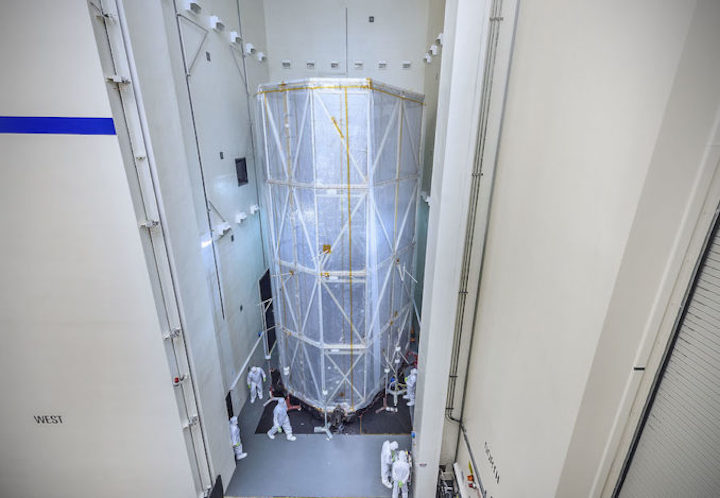
NASA officials identified several problems attributed to mistakes by the Northrop Grumman team: a damaged transducer that was incorrectly powered during testing, requiring replacement, valves in the spacecraft’s propulsion system that had to be replaced after they were improperly cleaned, and a catalyst bed heater that was overstressed at the wrong voltage.
Engineers also found tears in the sunshield membranes during a deployment test to check how the thermal barrier will unfold to the size of a tennis court once in space, and it took longer than expected to deploy, fold and stow the sunshield.
Workers at Northrop Grumman will connect Webb’s spacecraft and telescope elements for combined testing before shipping the observatory to its launch base in French Guiana. JWST will launch with its sunshield, solar panels, antenna and telescope mirrors folded up for launch, then will go through a weeks-long process to deploy the parts on the way to its observing station at the L2 Lagrange point nearly a million miles (1.5 million kilometers) from Earth.
The telescope has completed its standalone testing at NASA’s Goddard Space Flight Center in Greenbelt, Maryland, and at the Johnson Space Center in Houston. It was delivered to Northrop Grumman’s Redondo Beach facility earlier this year.
NASA said in March it would install more oversight over JWST in the future, including direct interaction with Northrop Grumman’s president and chief operating officer. NASA also planned to dispatch a project manager to Northrop Grumman’s factory in Southern California on a permanent basis, along with additional NASA spacecraft integration and test experts during critical operations.
NASA also added daily and weekly schedule reviews with Northrop Grumman, which will also revamp its management structure. Northrop Grumman is also making personnel changes and updating procedures, officials said in March.
Some of the mistakes described in March were caused by poorly written procedures, NASA officials said.
Kathy Warden, Northrop Grumman’s president chief operating officer, said in an April 25 conference call with investment analysts that JWST is a “first-of-a-kind” mission and marks a “huge technological leap” in spacecraft development.
“When people are doing things for the first time ever, there is learning that happens,” Warden said. “So we are ensuring that all of the training that we’re giving our people continues to be a focus, so that we can give them the best chance of success.
“Doing something for the first time does come with inherent risks, and we and NASA are partnering to identify that and successfully mitigate it, so that we can get this successfully launched and able to fulfill this space exploration mission that we all want to see be successful,” Warden said.
“The good news is now we have all the flight hardware,” she said. “The new launch date does reflect additional time for integrating and testing the telescope and the spacecraft, and it’s important for us that mission assurance is the top priority.”
An independent review board chaired by Thomas Young, a space industry veteran who served as an executive at Lockheed Martin and as mission director of NASA’s Viking Mars landers, will complete a report examining JWST’s technical, schedule and budget issues around the end of May.
The review will help NASA confirm a new launch date, now expected around May 2020, and a new cost estimate for the mission.
NASA EVALUATING JWST INDEPENDENT REVIEW REPORT
NASA is in the process of evaluating the report from the Independent Review Board chaired by Tom Young to assess the status of the James Webb Space Telescope (JWST). Established in March, the Board was due to submit its report on May 31. NASA said today that the Board has completed its work and briefed NASA. The report will be released later this month after NASA determines the impact on cost and schedule.
Thomas Zurbuchen, NASA Associate Administrator for the Science Mission Directorate, created the Webb Independent Review Board (WIRB) on March 27, the same day he announced another delay in the telescope’s launch. WIRB held its first meeting the next week.
For many years, JWST appeared to be on track for launch in October 2018 after a 2011 restructuring that followed a series of earlier cost overruns and schedule delays. Congress capped the development cost (not operations) at $8 billion in law. Pursuant to the 2005 NASA Authorization Act, if a program exceeds 30 percent of its baseline estimated cost, NASA must notify Congress and no money may be spent on it after 18 months from the time of that notification unless Congress reauthorizes it.
Last September, the October 2018 launch date slipped to sometime in the March-June 2019 period because of integration problems at the prime contractor, Northrop Grumman. Then on March 27, Zurbuchen and his deputy, Dennis Andrucyk, said the launch would be no earlier than May 2020 because of “avoidable errors” by Northrop Grumman during assembly and testing.
Zurbuchen and other NASA officials have insisted they would not know if the development cost will exceed the $8 billion cap until they have the results of the WIRB analysis. In a statement today, NASA said it will set a new launch date after evaluating WIRB’s analysis and that will lead to a new cost estimate.
NASA’s Independent Review Board (IRB) for the agency’s James Webb Space Telescope has completed its assessment of the observatory’s remaining critical tasks and briefed NASA officials. The agency is now evaluating the IRB’s findings and recommendations and will define the new launch schedule by the end of June. After the launch date is established, NASA will be able to provide a new cost estimate. NASA also is evaluating post-acoustic test results and will factor them into its schedule decision. — NASA, June 4, 2018
The “post-acoustic test results” in the last sentence refers to another problem that arose last month. Routine shock separation and acoustic tests designed to ensure the telescope can survive the stresses of launch resulted in fasteners that hold parts of the spacecraft together coming loose.
During a Town Hall meeting at the American Astronomical Society (AAS) conference in Denver today, NASA Astrophysics Division Director Paul Hertz presented a slide indicating that the WIRB report and NASA’s response will be released “in late June.”
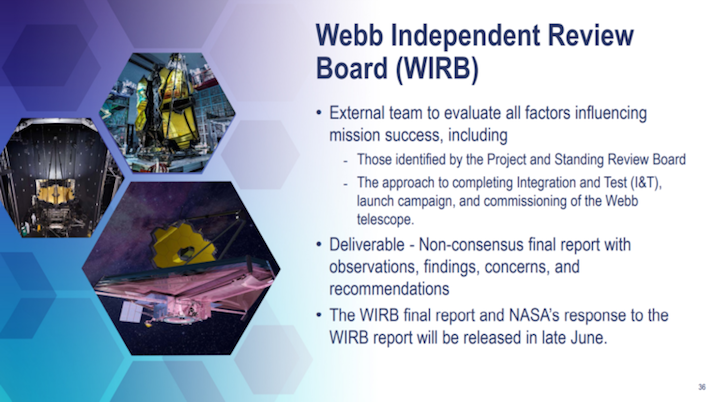
WIRB is chaired by Tom Young, a former director of NASA’s Goddard Space Flight Center who was President of Martin Marietta when it merged with Lockheed Martin. He is frequently called upon to chair failure review boards and other analyses of civil and military space programs that go awry. The other members are:
- Dr. William Ballhaus, Aerospace Corporation in El Segundo, California- Retired
- Mr. Steve Battel, Battel Engineering, Inc. in Scottsdale, Arizona
- Mr. Orlando Figueroa, NASA Headquarters and Goddard Space Flight Center in Greenbelt, Maryland – Retired
- Dr. Fiona Harrison, Caltech University in Pasadena, California
- Ms. Michele King, NASA Office of Chief Financial Officer/Strategic Investments Division in Washington, DC
- Mr. Paul McConnaughey, NASA/Marshall Space Flight Center/Webb Standing Review Board (Chair) in Huntsville, Alabama
- Ms. Dorothy Perkins, NASA Goddard Space Flight Center in Greenbelt, Maryland – Retired
- Mr. Pete Theisinger, Jet Propulsion Laboratory in Pasadena, California
- Dr. Maria Zuber, Massachusetts Institute of Technology in Cambridge, Massachusetts
Quelle: Space and Technology Policy Group
+++
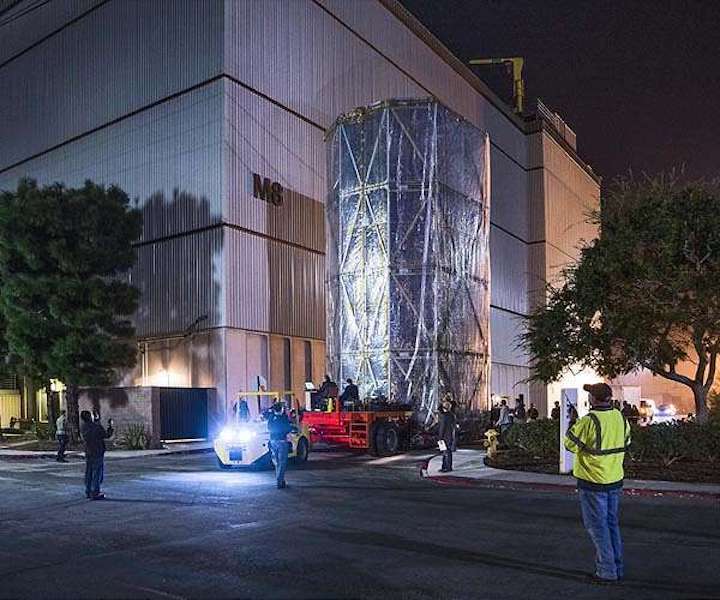
Before moving NASA's James Webb Space Telescope, and to assure that it's kept clean and safe, Webb got a very special wrapping treatment. The wrapping acts as a "mobile clean room," safeguarding the technological marvel from contaminants.
All satellites and observatories are created in clean rooms. Clean rooms filter out harmful contaminants, as even a speck of dust or a fingerprint could severely damage the sensitive instruments. So, to move satellites from place to place, as necessary during construction and testing, they need to be placed in a mobile clean room."
The mobile clean room, also known as the In-Plant Transporter, looks like a big silver box. Nestled inside, and visible through the translucent wrapping, is the Webb flight spacecraft element, comprised of the spacecraft bus and sunshield.
The mobile clean room is, essentially, a giant sealed bag that is purged with clean, dry air injected from pressurized bottles though a flexible tube. A small leak is included in the design so that the container can maintain positive pressure by releasing clean air while blocking air inflow. This same idea is applied to clean tents and clean rooms in buildings, which is evident when we open a door on a clean room and positive pressure inside the clean room forces air out in a gust and prevents dirty air from flowing in.
The spacecraft element recently was moved to a facility where it will undergo vibration and thermal-vacuum testing. In order to move it around, the spacecraft element is folded up, like it will be for launch. Even in this "stowed" condition, it still is about as large as a full-size school bus standing on end, and so requires big equipment to move it from one place to another and keep it clean during final assembly and testing.
After all the vibration and vacuum testing is completed, the Webb spacecraft element will be re-wrapped and returned to a clean room at Northrop Grumman's facility in Redondo Beach, California, where it will be assembled with the telescope element to form the full observatory that will fly in space.
The Gift that Will Keep Giving to Science
Once Webb launches in 2021, and is "opened" and functioning, Webb will be a present to scientists that helps them unwrap mysteries of the cosmos. It will bring countless discoveries to scientists and people around the world.
Webb will look far back in time to a period of cosmic history never seen before, seeking light from the early universe and watching how galaxies have evolved over time. It will study planets and other bodies in our solar system, and place it in context with other exoplanetary systems. Webb will study the physical and chemical properties of star systems and planet formation. It will also examine starlight filtered through exoplanetary atmospheres to learn about their chemical compositions.
Those are just some of the amazing things Webb will bring us after it's unwrapped, launched and in orbit.
Quelle: SD

